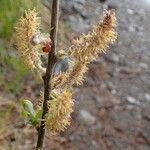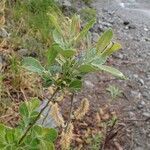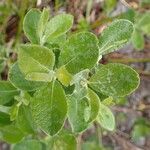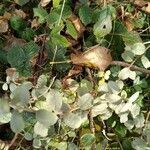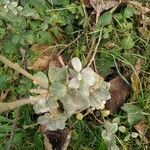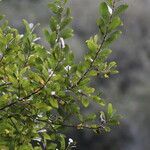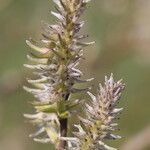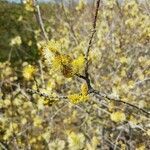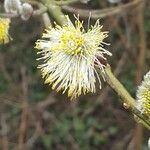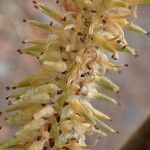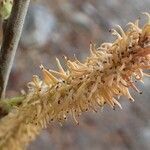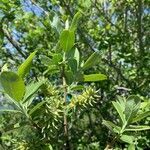Shrub or small tree to c. 7 m high, often only 1-2 m, spreading or often forming dense thickets; bark rather smooth. Shoots not brittle, grey or greenish grey and remaining hairy, or reddish to dark purple and often becoming glabrous or glabrate, generally with pale brown markings and striations prominent below surface for c. 2 years. Buds reddish, glabrate or hairy. Petiole to c. 1 cm long on adult shoots, but often very short, hairy. Lamina 2-7 × 1.5-3.5 cm, often smaller at base of lateral shoots, generally obovate, sometimes elliptic, not bitter to taste, grey or glaucous below, generally ± densely clothed in soft grey hairs, sometimes rather sparsely clothed in harsher reddish brown hairs, soon glabrous and shining above except for midrib, glandular-serrulate to subentire; angle between midrib and veins > 45°; apex rounded to cuspidate. Stipules semi-annular, small, persisting on strong vegetative shoots. Catkins appearing before lvs, ? or ?, 1.5-3.5 cm long, broad-cylindric to cylindric-ovate, ± erect; rachis villous. Bracts 1.5-3 mm long, elliptic to oblong-obovate, black in upper 1/2, sericeous; apex obtuse to rounded. Gland 1, 0.5-0.8 mm long, ± rectangular to almost square. Stamens 2; filaments pilose towards base. ♀ fls with pedicels > bracts; ovary white-tomentose, stalked.
Shrub or small tree to about 8 m tall, branching from ground into many erect stems; bark smooth, grey-brown; twigs dull grey, softly hairy when young. Leaves broadly obovate to elliptic, acute, cuspidate or shortly acuminate, 3–9 cm long, 2–4 cm wide, entire or denticulate, sometimes crisped; base rounded to broadly wedge-shaped; upper surface green, sparsely pubescent; lower surface densely pubescent or velvety, the indumentum sometimes confined to the closely reticulate veins, rarely glabrescent and variably glaucous; petiole 2–5 mm long, densely pubescent; stipules minute or up to 5 mm long, ovate. Catkins appearing before the leaves from large brown buds on previous year's shoots. Male catkins sessile, ovoid, 15–30 mm long, 15–20 mm diam., the densely crowded flowers subtended by short, blackish, densely pilose bracts; stamens 2. Female catkins cylindrical, shortly pedunculate, 20–40 mm long, 10–20 mm diam. Fruit cylindrical, silky-pubescent, tapering to the sessile stigma.
Shrubs to 5 m tall; bark dull gray. Branchlets densely gray tomentose. Buds brown, flattened oblong, gray tomentose. Stipules reniform or semiovate; petiole 5-7 mm; leaf blade long obovate or obovate-lanceolate, 4-10 × 1-1.5 cm, larger on shoots, abaxially densely gray tomentose, adaxially dull green or grayish green, base attenuate, margin shallowly serrulate, rarely entire, apex acute; lateral veins raised abaxially. Flowering precocious or coetaneous. Male catkin 1-2 cm; bracts brown, spatulate, long pubescent. Male flower: stamens 2, distinct, glabrous; glands adaxial. Female catkin 3-4 cm; bracts as in male catkin. Female flower: gland as in male flower; ovary long conical, densely gray tomentose; stipe rather long; style short; stigma divided. Fl. May, fr. May-Jun. 2n = 76.
A European sp. with obovate to suborbicular lvs 5–13 x 2.5–5.5(–8) cm, apiculate to shortly acute, ± crenate-serrate and tomentose, with irregularly revolute margins, otherwise much like no. 23 [Salix discolor Muhl.], furnishes the pussy-willows of florists for Easter-decorations. It occasionally escapes about nurseries.
With more tomentose, narrower lvs than S. caprea, acute at both ends, is similarly used and rarely escapes. The long prominent ridges on decorticated wood are distinctive.
